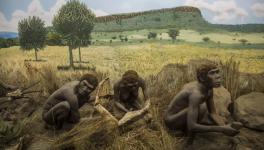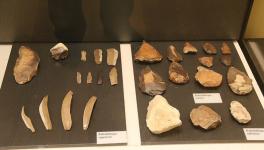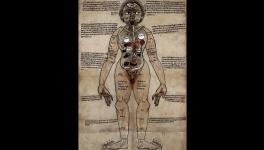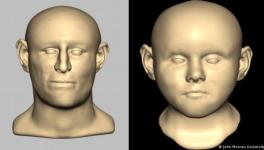Was Sphere the First Geometrical Form Made by Humans?

Representational image.
Important scientific advances are changing what we know about the technological, social, and cognitive traits of our ancient human ancestors. The invention of the first stone tools was a hugely significant milestone along the human evolutionary highway, one that would change our lifeways and, ultimately, distinguish our genus Homo from all other living beings on the planet.
Many very significant discoveries have been brought to light only over the last 25 years or so, deepening our knowledge about where, why, and how the first primitive technologies occurred.
Meanwhile, a state of angst resulting from our growing alienation from Nature is sharpening our need to understand how the evolution of technology has brought us to this point.
In order to understand this phenomenon, it is vital that we turn our gaze toward the distant past.
Stone tool-making is often lauded as the characteristic that defines us as ‘human’. Indeed, the first member of our genus was fittingly named H. habilis– meaning, ‘handyman’ for this very reason. But we now know that stone toolmaking appeared more than 3 million years ago in Africa: even before our genus emerged on the scene. This underpins evidence suggesting that other non-Homo primates, like the robust Paranthropus, were also capable of making stone tools.
Of course, our primate cousins, like chimpanzees and bonobos, often come to mind when we look for behavioural analogies for toolmaking among other animals, while we often forget that many other creatures, including crows, elephants, and even octopus, also make simple tools and use them for sustenance-related activities.
Hominins probably began to use stones for throwing, pounding, breaking, or crushing other materials. Systematic methods designed to break stones intentionally evolved only much later, probably when hominins began to exploit the sharp edges on broken stones to carry out a variety of tasks, such as scavenging protein-rich viscera and meat from large mammal carcasses.
This groundbreaking discovery heralds the Oldowan and the beginning of a very long period of relative cultural stability. For more than three million years, hominins used toolmaking to carve out their own niche in the paleolandscapes, where they thrived alongside other animals.
This behaviour would prove to be a successful adaptive choice, one that resulted in increasing the density of hominin populations, who would soon spread out of Africa into Eurasia.
The subsequent Acheulian cultural period, characterised by standardised stone tools with preplanned morphologies, broadly associated with H. erectus sensu largo, replaced the Oldowan in different parts of the globe between 1.75 and one million years ago.
In spite of relative cultural stability, pioneering archaeologists like Mary Leakey remarked more than half a century ago that evolutionary changes can, in fact, be recognised in the latter phases of the Oldowan and Early Acheulean layers in the Olduvai Gorge in Tanzania.
One of the most important is the shift from non-standardised flake-core industries to preconceived tool types, among which, ‘spheroids’ are both the first and the most representative.
As their name suggests, spheroids present a rounded morphology, formed by adjoining faceted surfaces. While extremely rare in Europe, they have been found elsewhere in Africa and the Near East, India, and Asia, in contexts ranging from as early as 1.8 million years ago, up to around 300,000 years ago.
Yet, in spite of their ubiquity, these mysterious stone balls continue to puzzle archaeologists, whose opinions remain divided as to whether they were purposefully made following a planned stone-knapping strategy or, alternatively, if their rounded shape was obtained accidentally as a result of prolonged hammering carried out with the same stone.
Up to now, the famous tear-shaped bifaces of the Acheulian, broadly associated with H. erectus sensu lato, were commonly believed to be the first deliberately shaped object ever made by our human ancestors.
But if indeed it can be demonstrated that spheroids were made using a preplanned stone reduction strategy, this would imply that the sphere was the first geometrical shape ever manufactured by early humans.
Recently, renewed interest in these mysterious stone balls has been driving archaeologists to develop innovative scientific methods to resolve this central issue of ‘intentionality’: are spheroids manufactured tools or simply extensively used hammers?
While the issue remains unresolved to this day, researchers are making headway in addressing the many questions shrouding our knowledge about spheroids.
For example, one recent study applied cutting-edge 3D analytical methods to study a collection of stone balls from the Early Acheulean Levantine site of ‘Ubeidiya, allowing for the first time to identify patterns suggesting that a purposeful manufacturing process to produce almost perfectly spherical stone balls did indeed exist.
Meanwhile, other strategies involving experimental archaeology are helping scientists to test these theories. Results show that even expert stone knappers find reproducing stone spheres using prehistoric technologies a daunting task requiring complex volumetric planning and deep knowledge of stone fracture mechanics.
While we endeavour to discover the gestures and cognitive processes required to make these tools, we also ask ourselves what spheroids might have been used for. Some have suggested that they were tools for butchery, while others have proposed that they were tools for processing meat or plant fibres.
The dimensional standardisation of these fist-sized objects is sometimes alluded to in support of the idea that spheroids could have been used as projectiles. Some archaeologists have suggested that spheroids could even have had some kind of cultural or symbolic significance.
As we advance in scientific research about the past, so do we uncover the deep complexity behind the ancient technologies that have made our species so unique.
Deborah Barsky is a researcher at the Catalan Institute of Human Paleoecology and Social Evolution and associate professor at the Rovira i Virgili University in Tarragona, Spain, with the Open University of Catalonia (UOC). She is the author of Human Prehistory: Exploring the Past to Understand the Future (Cambridge University Press, 2022). Deborah is presently leading a project with the IPHES-CERCA funded by the Gerda Henkel Foundation in collaboration with researchers from the Computational Archaeology Laboratory of the Hebrew University of Jerusalem and Tel Hai College (Upper Galilee).
This article was produced by Human Bridges, a project of the Independent Media Institute.
Get the latest reports & analysis with people's perspective on Protests, movements & deep analytical videos, discussions of the current affairs in your Telegram app. Subscribe to NewsClick's Telegram channel & get Real-Time updates on stories, as they get published on our website.
























